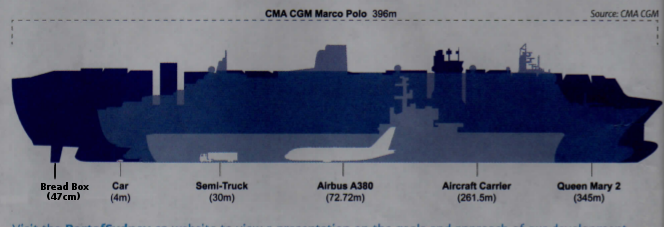Tucked into the F.A.S.T. Furniture flyer in the Saturday, January 2, 2016 edition of the Cape Breton Post was an eight-page update on the Port of Sydney.
If you haven't read it yet, I recommend the graphic on the inside cover page:

It shows the silhouettes of a number of vehicles and vessels superimposed over that of the Marco Polo (a 360 meter-long, 16,000 TEU container ship owned by the French container shipping company CMA CGM). It's highly informative for those of us who did not know that the new “super” ships are bigger than the Queen Mary 2, an aircraft carrier, an Airbus A380, a semi-truck, a car and a bread box. (Full disclosure: I added the bread box.)
New & Unusual
The heart of the flyer, to my mind, is the “What's New” in the Port of Sydney section. There are four "new" items, but the one I'd like to focus on is the fourth: the “Foreign Trade Zone" (FTZ) designation we're seeking. While on the surface this would seem to be the most novel development at the port, it is actually the least original: it's been done before.
Sydport was designated as “Canada's first Free Trade Zone” by John Buchanan's provincial government in 1983. Discussing the plan in the Cape Breton Post on March 10th of that year, then-Development Minister Roland Thornhill said:
“No area of the country has been studied like Cape Breton has and it's got a multiplicity of development agencies and government support programs.
“Now governments are running short of money and you've got to start using your brains.”
Thornhill is on record speculating that the free-trade zone designation might not just rejuvenate the Cape Breton economy but make it as "vigorous as Hong Kong's."
And if you're thinking, “How can a Canadian province designate a free trade zone?” Rollie Thornhill would be proud—you're clearly using your brains.
The Cape Breton Development Corporation (DEVCO, which owned Sydport at that time) and the province formed a company, Sydport International Trade Zone Ltd (SITZ) that was to operate for a five-year trial period. And while SITZ may have been the only zone of its kind in Canada, the U.S. had 250 free-trade zones at that time—80 of them active.
The difficulty of running a free trade zone without what we would today call “buy-in” from the federal government soon became apparent. According to a 1985 Touche Ross and Co. consultant's report, to operate properly, SITZ needed changes in the federal Custom's Act, the Excise Act, the Customs Tariff and the Income Tax Act, “as well as other measures," none of which was forthcoming.
Those running the park already knew there were bugs to be worked out: having lost out on a contract to warehouse clothing because of government quotas on clothing imports for 1984, they were requesting permission to store goods in excess of quotas. The park was also requesting the right to allow companies to import raw materials and process them in the free trade zone. Sydport manager Floyd MacAulay told the Post on October 28, 1985 that companies still had to pay tax on the value of labor and materials needed to complete the work. "There's nothing to cause an importer to set up a processing operation here," he said.
In April 1986, the Post reported that Thornhill was calling on the Mulroney government to improve Sydport's status by making it a “true” international trade zone, but the government wasn't biting. According to the Post, the feds were reluctant to act because of the number of provinces that would want to offer ITZ services.
Instead, the federal government was busy negotiating the Canada-US Free Trade Agreement which, as the Chronicle Herald reported on March 21, 1989, along with “changes in European trading practices," raised questions about “the value of such zones" in general.
And so, SITZ died a death. By 1989, it had cost the provincial government and DEVCO thousands of dollars in consultants' fees, leasehold improvements and operating grants.
As he pulled the plug on the failed provincial free trade experiment, then-Nova Scotia Industry Minister Donald Cameron told the Post that SITZ had been “a disaster from start to finish” and “a glorified and unsuccessful customs brokerage with warehouse facilities.”
The "takeaway" for modern day port developers?
Don't count your free trade zones before they're hatched.





1
Log In or Sign Up to add a comment.- 1
arrow-eseek-e1 - 1 of 1 itemsFacebook Comments